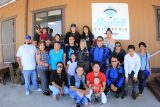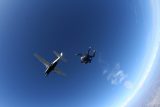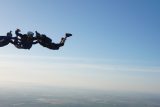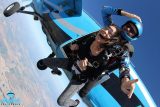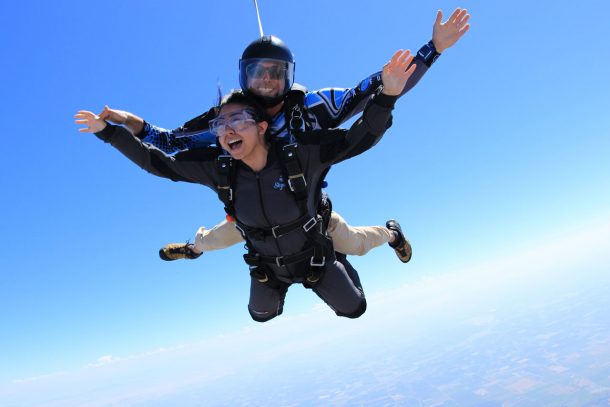What Do You Need to Do to Skydive By Yourself?
When it comes to skydiving, you could say that flying solo is quite the achievement. That being said, you may wonder what are solo skydiving requirements? What makes skydiving solo so special? Tandem skydiving is a fine fit for many, and we recommend it as a way to develop a sense of what the skydiving experience is like. While for some skydiving is a “one and done” sort of deal, we often see many for whom one tandem skydive just isn’t enough—they have the desire to fly free. We can’t blame them. There is truly something magical about your first-time skydiving solo: no one attached, no instructors alongside you, just yourself, and an expanse of Northern California sky.
Sounds sublime, doesn’t it? So, how do you get to that point? What are the requirements to skydive solo? These questions have tiered answers. On the one hand, solo skydiving requirements are pretty straightforward. You need to be at least 18 years of age, and you need to weigh less than 225 pounds. Skydiving solo, though, requires a bit of training at the start.
Even Birds Need a Little Lift
Birds do not hatch, begin to flap, and start flying. Even this creature, to whom flight is “instinctual,” requires a little training and a lot of practice. The first time the bird falls from the nest, it may realize flexing her wings slows the fall. The second time the bird slips from the branch, it discovers flapping keeps the descent from being so darn dramatic, but flapping does not equate to flying. That minimal experience with flight doesn’t mean the bird can now fly. Rather, learning to fly is a process, and only with practice does a bird finally take flight.
So, why are we telling you all this when you are looking for solo skydiving requirements? It is because, like the bird learning to soar, skydiving solo requires training and practice. Here at Skydive California, training and practice come in the form of Accelerated Free Fall (AFF).
Accelerated Free Fall

Accelerated Free Fall is a seven-level program that prepares you to skydive solo. When you make a skydive through this program, you will have an instructor alongside you rather than attached to you like during a tandem skydive. On each AFF jump, with your AFF instructor’s guidance, training, and debriefing, you will begin to develop your solo skydiving skills and your canopy flight skills. To meet the requirements to skydive solo, you will need to demonstrate to your instructors that you have mastered various body flight skills. Once you do that, you are good to go. That’s right, no instructors. You will truly be skydiving solo.
Then Add Friends!
Admittedly, after a while, you’ll miss having some company. After all, skydiving solo is nice, but sharing skydiving smiles with your pals…man, now that is really something! The way to reach this point is to receive your USPA A license. At Skydive California, we offer a full skydiving A License Program, so you can get the coaching, gear rentals, and jumps that you need to succeed and receive your first skydiving license. With this certification, you are cleared to jump with other licensed skydivers and can start adding all your new skydiving friends to the mix. In no time at all, you can go from skydiving solo to building all sorts of neat formations with your best sky buddies.

Interested in learning more? Give us a call. We would love to talk more about solo skydiving requirements, AFF, and A License certification. You read more about learning to skydive at Skydive California (near the Bay Area) here!
